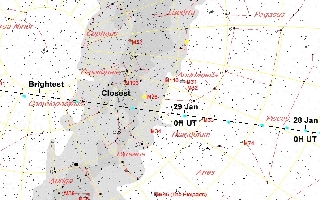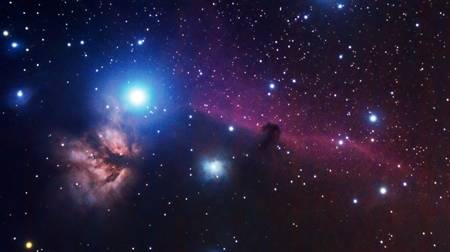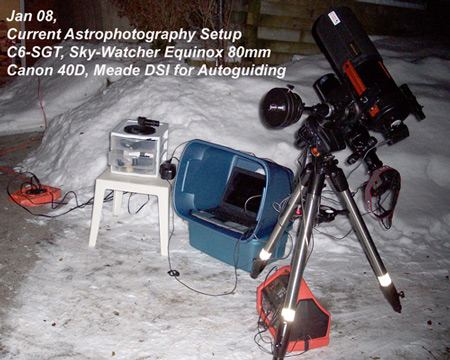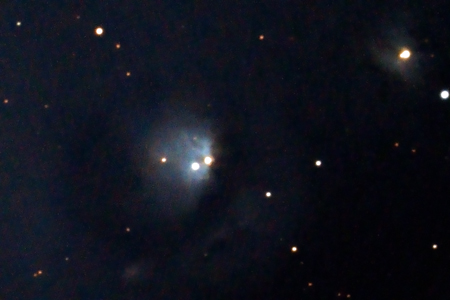Due to a waxing moon with an 81% illuminated disk transiting at 9:01pm I waited until midnight to start my observing session on Saturday night (Sunday morning). I wanted to try to avoid the worst of the moon’s glare if at all possible.
Unfortunately there was a trade-off with this scenario: a couple of interesting objects I had planned to observe in Lepus disappeared behind the roof of my house and behind a very “mature” tree. I was surprised to see Orion dip so low towards the western horizon.
It was quite cold again and worse, ice was adhering to the patio stones in quite a stubborn fashion. I got (another) workout trying to remove it.
The first object I observed was the “Clown” or “Eskimo” Nebula (NGC 2392)in Gemini. The Clown is a planetary nebula, where a dying star that is running out of nuclear fuel sheds its outer layers into space. In the March edition of Sky & Telescope Timothy Beers writes that certain “intermediate” types of planetary nebulas are thought to be responsible for dispersing elements into space and eventually these elements “make their way into the next stellar generation. As stars form, evolve, and die, they cook light elements into heavier ones – including those we need for life.” Something to think about as I observed NGC 2392. I could not make out the layered shapes that make it look like an Eskimo with a fur parka hood or a clown’s face. I could see the layers but not distinctly. Back in early December on one of the first nights I had the telescope out I observed this object and I saw more detail.
I had better luck with another planetary: NGC 3242 or “The Ghost of Jupiter”. The nebulosity seemed larger and brighter than with the Clown. The broken-spiral shapes (layers) remind me somewhat of the child’s toy “Spirograph”, but looking as if you made a messed up one.
The moon was still pretty high up so I passed on trying to view any Messier objects. I mean, why torture yourself, the bitter cold is bad enough. “I Want To See (Things)!!!” as Joan Crawford exhorted in an old episode of Night Gallery (a very young Steven Spielberg’s first directing gig). But I digress.
Scrolling through the Celestron’s database through to Variable Stars I keyed in R Leonis. R Leonis is a Mira-type pulsating variable in Leo. It’s magnitude ranges from 5.8 to 10. To me it has a distinctly orange cast. Quite bright. One can keep checking in on this star to see if it is getting brighter or is dropping in brightness. I have not tried to determine the magnitude of variable stars before, but I might start.
Next stop was V Hydrae, a carbon star. I could not find this star on the telescope’s database so I keyed in the coordinates for Right Ascension (10h 51.6m) and Declination (-21 degrees 15′) on the telescopes hand-set under the Go-To RA/Dec. utility and the Celestron slewed right to it. This star looked like an intensely red little point of light over towards the southwestern horizon. According to the “Celestial Sampler” by Sue French V Hydrae is “a dying red-giant star ready to form a planetary nebula”. So perhaps in a thousand years this object will look more like the Clown nebula than the bright little red light it is now.
One of the objects I missed by starting so late was R Leporis or Hind’s Crimson Star, another carbon star and a variable to boot, in Lepus. Maybe next time.
I observed Saturn (how can one ignore Saturn?) again. This time I could see Titan at around 3:00 o’clock at a fair distance from the planet, and then closer to the planet another bright moon, probably Rhea. Again closer to the planet I could just see another speck of light, which turned out later to be Dione. That was all I could see, not as good as Monday when I saw 5 moons.
I ended the observing session with M40, a Messier object that is actually a double star. I put very high power on this double and I still could not split it. There seemed to be a orangey-yellow star extremely tight in to a bluish white star. Nice colours. Can anyone let me know why a double star is a Messier object? Did it look like a comet to Messier?
I hope I have some energy left for observing the Lunar Eclipse at Binbrook, weather permitting. The SCT is not ideal for observing a lunar eclipse. Hopefully I’ll re-energize by Wednesday night.

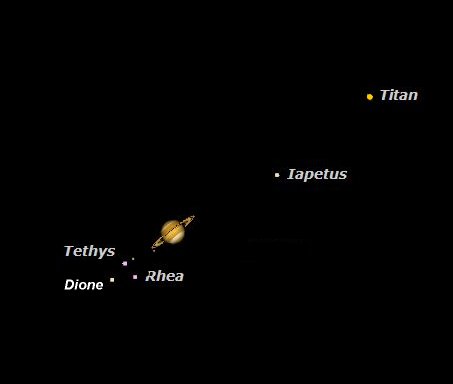
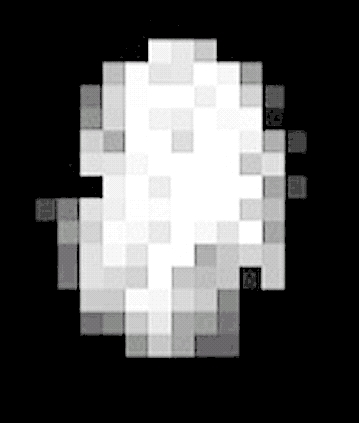
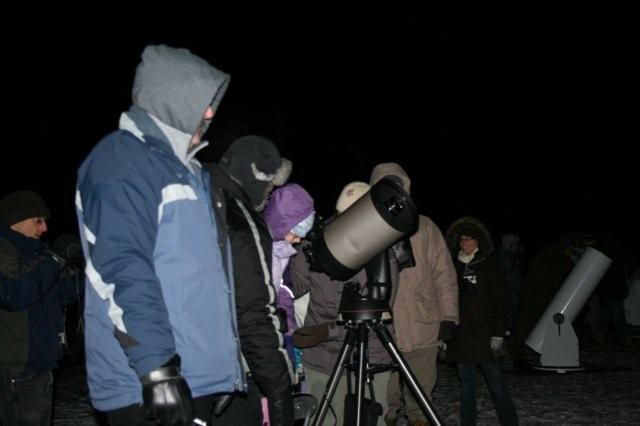 Jim showing off Orion
Jim showing off Orion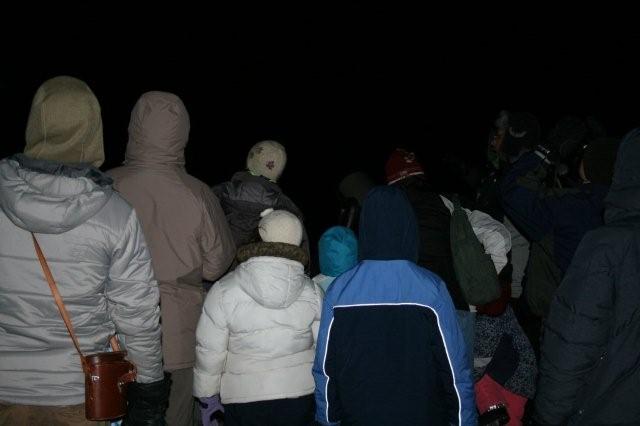 Awe inspiring
Awe inspiring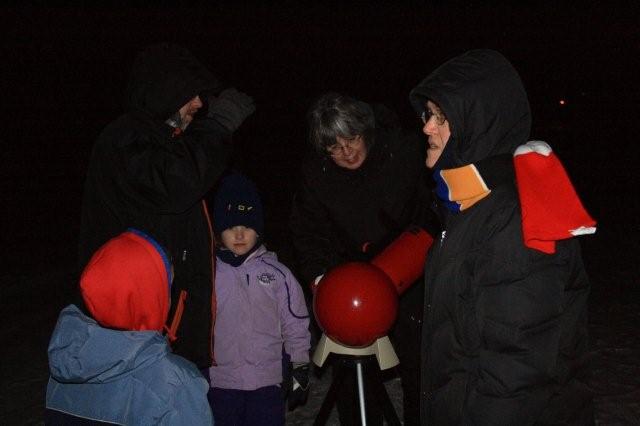 Ann holding court
Ann holding court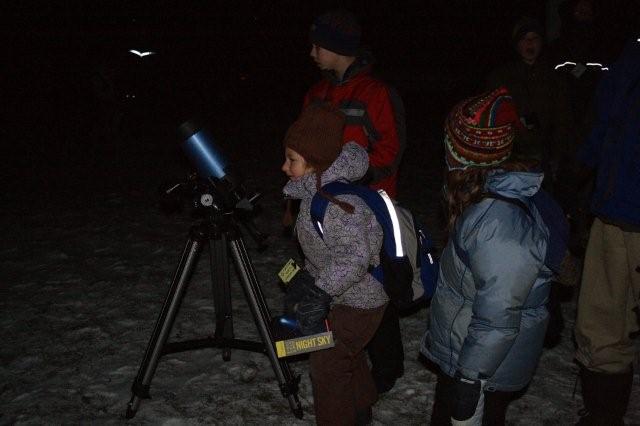 A future HAA member
A future HAA member